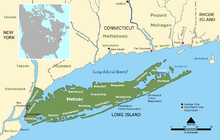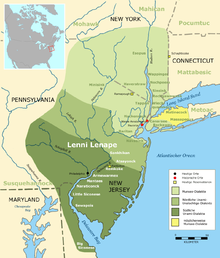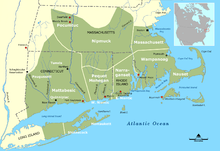- Metoac
-
 A modern map showing Long Island and most of New York City highlighted in green with locations and tribal exonyms[dubious ]
A modern map showing Long Island and most of New York City highlighted in green with locations and tribal exonyms[dubious ]
 A modern map broadly showing language areas in the Mid-Atlantic region at the time of European contact in the 17th century[dubious ]
A modern map broadly showing language areas in the Mid-Atlantic region at the time of European contact in the 17th century[dubious ]
Metoac is the collective name for the group of culturally and linguistically related Native American settlements roughly east of what is now the Nassau County line on, Long Island in New York at the time of European contact in the 17th century. Metoac does not specifically refer to political, cultural, linguistic, or social bonds, but is a geographic term. It is sometimes erroneously applied to the non-existent Thirteen tribes of Long Island first referred to in a 19th-century book by the local amateur historian Silas Wood, and since often quoted and repeated in many other works.
The term is likely derivative of metau-hok, the local word for the rough periwinkle,[1] which played an important role in the economy of the region before and after the arrival of Europeans. Long Island was first settled by colonialist from New Netherland and New England in the mid 17th century and became important trade partners, particularly in the supply of sewant, an alternative currency.[original research?] Indigenous populations declined significantly within a few decades. Derivatives of the many of the place names given by the indigenous populations are sill in use today. Small groups of surviving Native Americans have had success in gaining official state and federal status as tribes, and maintain reservations on or close to the East Fork of the Island.
Contents
Language
The Native American population was estimated at 10,000 at the time of first contact.[citation needed] They spoke two languages within the Algonquian language group, reflecting their different connections to mainland peoples.[2] Those from the west in and around what is now New York City spoke one of the R-dialects of what is now known as "Delaware languages", (a Lenape - also known as the Delaware - language spoken in New Jersey, Lower Hudson Valley, New York Harbor and eastern Pennsylvania). Those living in the east spoke Mohegan-Montauk-Narragansett language, a Y-dialect similar to the Pequot of eastern Connecticut.[citation needed]
European colonizaion
Europe colonalization of the region begun in the 1620s. From the north the New England Confederation exerted influence on eastern Long Island and along its north shore. The western portion (including what is now the New York City boroughs of Brooklyn and Queens were under the jurisdiction of New Netherland. This was formalized in the Treaty of Hartford in 1650 which set a border running south from Oyster Bay. The Native Americans on Long Island played an important role in the trade economy as shells harvested there fashioned into small beads to create sewant, or wampum ("wampompeag" - shortened later by the English) were the most highly prized.
Displacement
The Pequot War and Kieft's War were two major conflicts involving the indigenous and immmigrating populations and are considered[by whom?] early genocides of Native Americans.[citation needed] Exposure to new Eurasian infectious diseases, such as measles and smallpox, dramatically reduced the numbers of Native Americans on Long Island.[citation needed] In addition, some Native American settlements on Long Island migrated away under pressure from European settlement.[citation needed] By 1659, their population was reduced to less than 500.[citation needed] After the American Revolutionary War their numbers were reduced to 162 people by 1788.[citation needed] By this time, Samson Occom had persuaded many survivors to join the Brothertown Indians off-island.[citation needed]
Exonyms
Further information: Toponymy of New NetherlandFurther information: List of place names in New England of aboriginal originHistories of Long Island had long asserted there were multiple tribes on Long Island. Contemporary historian John A. Strong of Southampton College has demonstrated that documents indicate names commonly used to identify a people, or "tribe", on Long Island were instead European transliterations of indigenous language place names.[3] For generations, the place names were mistakenly used as exonyms for peoples, not places. Among the many locations on Long Island used by the native population the following thirteen were used in early publications to describe individual goups [4][5]
- Canarsie - in modern day Brooklyn, New York and Maspeth, Queens, and Jamaica, New York. Legend states that the Carnarsee sold Manhattan to the Dutch Governor Peter Minuit for "24 dollars' worth of beads and trinkets.".[6]
- Corchaug (Cochaug)(Cutchogue) - Around Riverhead, New York and Southold, New York. The Fort Corchaug Archaeological Site is on the National Register of Historic Places.
- Manhasset (also known as Manhansick) - Located on Shelter Island, New York. Its name is applied to Manhasset, New York
- Marsapeague (also known as Massapequa, Marsapequa, Maspeth), - Located on the south shore from the Rockaways into Suffolk County. Massapequa and Maspeth, Queens are derivations of this.
- Matinecock (also known as Matinecoc) - Located on the Long Island North Shore from Flushing, Queens to Huntington.
- Mericoke (also known as Merrick, Meroke, Merikoke, Meracock) - Located on the south shore from the Rockaway into Suffolk County. Merrick is a derivation of this.
- Montaukett (also known as Montauk, Meanticut)- Located in East Hampton, New York. Its sagamore Wyandanch had his name on the title transfer of most of Long Island to the European settlers.
- Nissequaq (also known as Nesaquake, Missaquogue)- Located on the North Shore from Fresh Pond to Stony Brook, New York. The village of Nissequogue and the Nissequogue River are named after this.
- Rockaway (also known as Rechaweygh, Rechquaakie)- Located around Rockaway and portions of Jamaica and Maspeth The Rockaways is a place name derived from this.
- Secatague (also known as Secatoag, Secatogue) - Located at Islip on the south shore.
- Setauket (also known as Setalcott) - Located on the North Shore from Stony Brook to Wading River, New York. The village of Setauket is named after this.
- Shinnecock Indian Nation - Located in Southampton, New York. They occupy the Shinnecock Reservation, New York.
- Unkechaug (also known as Patchogue, Onechechaug, Patchoag, Unchachaug, Unquaches, Unquachog, Unquachock, Unchechauge) - Located on the south shore from Brookhaven, New York to Southampton, New York.
State and federal recognition
At the end of 2009, the administration of President Barack Obama announced the Shinnecock Indian Nation had met the federal criteria for recognition as a tribe.[7] While the final ruling is subject to a comment period, it is likely the announcement will stand. New York State has recognized the Shinnecock, based at Shinnecock Reservation near Southampton and the Unkechaugi, whose Poospatuck Reservation at Mastic is the smallest Indian reservation in the state. The Montaukett, a group around Montauk, is seeking both state and federal recognition.
References
- ^ http://books.google.com/books?id=CvHXAAAAMAAJ&q=Metoac&dq=Metoac&hl=nl&cd=8
- ^ Barron, Donna. The Long Island Indians and their New England Ancestors: Narragansett, Mohegan, Pequot & Wampanoag Tribes. AuthorHouse. June 28, 2006. ISBN 978-1425934057
- ^ Strong, John A. We Are Still Here: The Algonquian Peoples of Long Island Today, 2 edition. New York: Heart of the Lakes Publishing, June 1998. ISBN 978-1557871527
- ^ Nathaniel Scudder, A History of Long Island From Its First Settlement By Europeans to the Year 1845, New York: 1845
- ^ http://www.accessgenealogy.com/native/tribes/brotherton/metoachist.htm
- ^ Islands Draw Native American, Dutch, and English Settlement - city-data.com - Retrieved December 1, 2007
- ^ Hakim, Danny (2009-12-15). "U.S. Eases Way to Recognition for Shinnecock". New York Times. http://www.nytimes.com/2009/12/16/nyregion/16tribe.html. Retrieved 2009-12-17.
Categories:- Suffolk County, New York
- Nassau County, New York
- Native American tribes in New York
- Algonquian peoples
- Algonquian ethnonyms
- People of New Netherland
Wikimedia Foundation. 2010.

